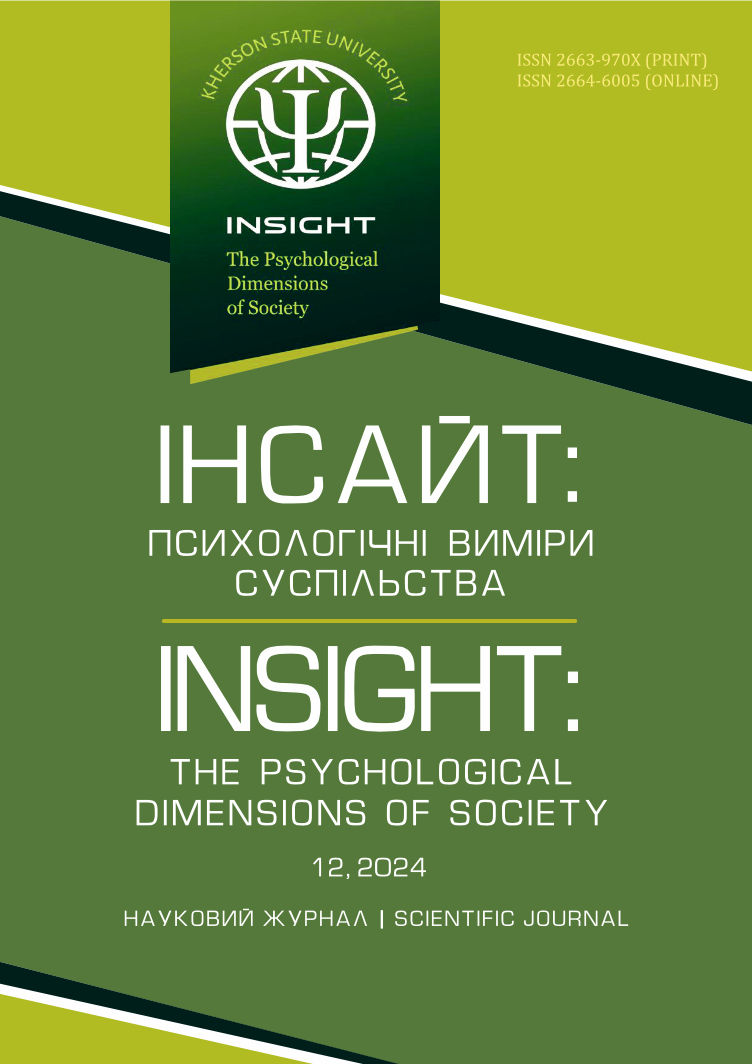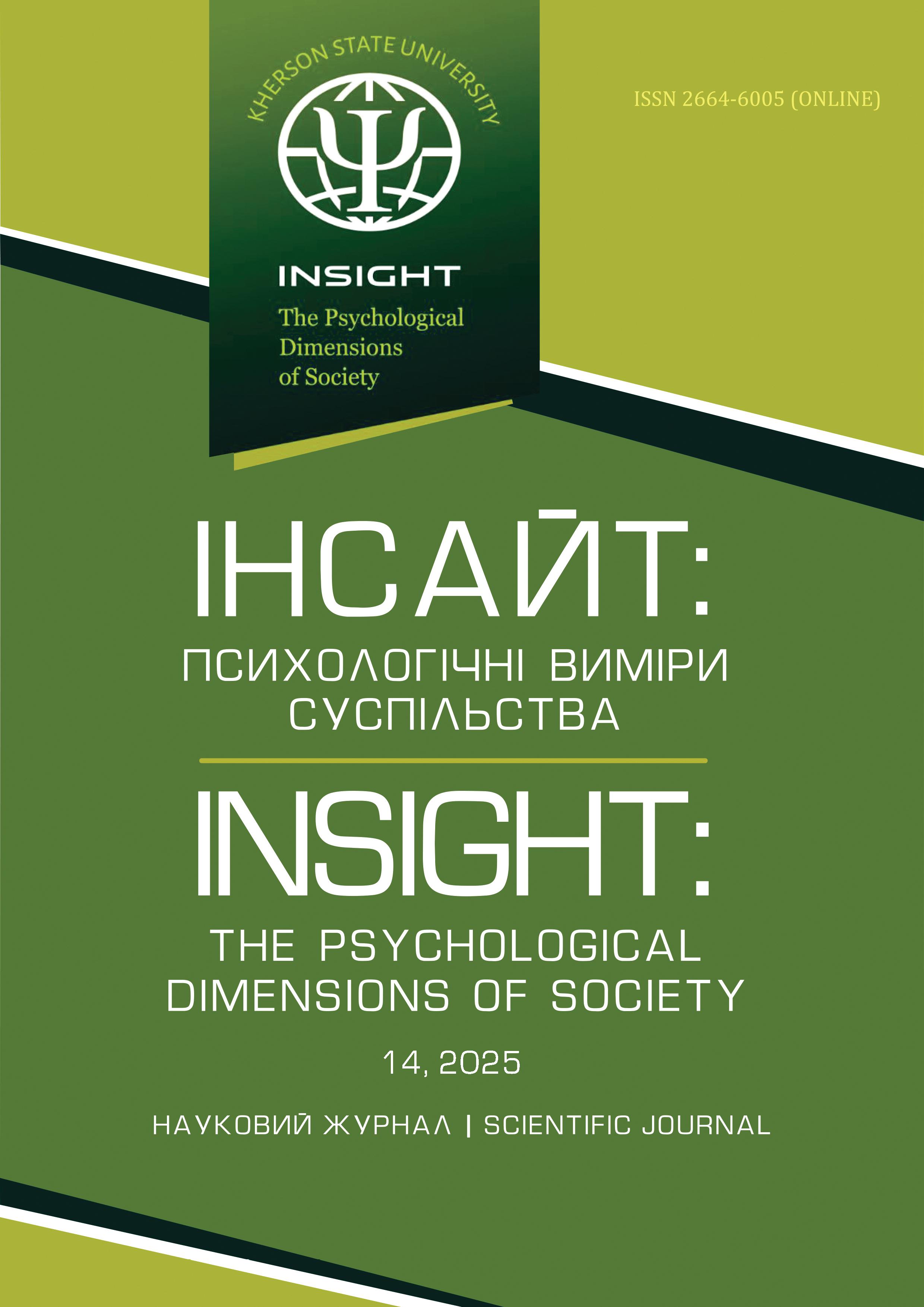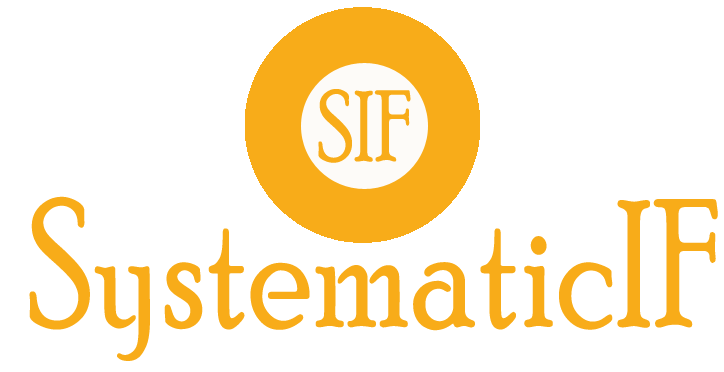Features of the Attributional Style of Individuals with Alexithymia and Psychopathy
Abstract
The aim of the study is to determine the features of the attributional style of individuals with alexithymia and psychopathy. Methods. Theoretical methods: analysis and generalization of theoretical propositions related to the research problem, based on a review of scientific sources and research data; empirical methods: Seligman Attributional Style Questionnaire (Seligman, 2006), 26-item Toronto Alexithymia Scale (Taylor et al. 1985), Levenson Self-Report Psychopathy Scale (Levenson, 1995); methods of mathematical statistics. Results. The interrelations between alexithymia, psychopathic traits, and attributional style were studied. A negative correlation between alexithymia and the general level of optimism was established (R = –.32; p < .010). It was found that the primary factor of psychopathy has a weak but significant direct correlation with alexithymia (R = .20; p < .050). Secondary psychopathy has a high direct correlation with alexithymia (R = .46; p < .010). It was determined that the primary factor of psychopathy has a direct correlation with the general level of optimism (R = .29; p < .010). A negative correlation between secondary psychopathy and the general level of optimism was noted (R = –.28; p < .010). Numerous significant inverse correlations between specific cognitive attitudes that constitute an optimistic attributional style, alexithymia, and the secondary factor of psychopathy were identified. Discussion and Conclusions. The specific features of the attributional style of individuals with alexithymia and psychopathy were determined, and the connections of psychological constructs with the components of the attributional style were clarified. The presence of a relationship between alexithymia and primary and secondary psychopathy was demonstrated. It was found that individuals with alexithymia and secondary psychopathy are characterized by a pessimistic attributional style, whereas those with primary psychopathy are characterized by an optimistic attributional style. The attributional style of people with secondary psychopathy is mainly depressogenic, in contrast to people with primary psychopathy, in whom such a feature is not observed. The study results may be useful in choosing psychocorrectional strategies for individuals with alexithymia and psychopathy.
Downloads
References
Alex J., Bhatia J. K., Marakwar A. Optimism and PTSD: A Review. International Journal of Indian Psychology. 2024. Vol. 12(1). P 246–254. URL: https://ijip.in/articles/optimism-and-ptsd/
Almansa J. F. F., Trivilin T., Hutz, C. S., de Almeida R. M. M., Vazquez, A. C. S., de Freitas, C. P. P. Mental health of Brazilian students during the COVID-19 pandemic: the role of gratitude, optimism, and hope in reducing anxiety. Trends in psychiatry and psychotherapy. 2024. Vol. 46, e20220496. P. 1–9. https://doi.org/10.47626/2237-6089-2022-0496
Batky B. D., Mendez B., Bontemps A., Salekin R. T. Psychopathy measurement practices moderate psychopathy’s association with anxiety and depression: A comprehensive meta-analysis. Clinical Psychology Review. 2024. Vol. 111, 102448. https://doi.org/10.1016/j.cpr.2024.102448
Boccio C. M., Beaver K. M. Psychopathic personality traits, intelligence, and economic success. The Journal of Forensic Psychiatry & Psychology. 2015. Vol. 26(4). P. 551–569. https://doi.org/10.1080/14789949.2015.1037330
Corso C. B., Hoppe R., Kliewer W., Wike T., Winter M. A. Emotion Regulation in Families: Exploring the Link between Parent-Child Alexithymia and Child Post-Traumatic Stress Symptoms Amidst the COVID-19 Pandemic. Child Psychiatry & Human Development. 2024. P. 1–12. https://doi.org/10.1007/s10578-024-01728-9
Estévez A., Jauregui P., Momeñe J., Etxaburu N., Lopez-Gonzalez H. Hopelessness in gambling disorder: relationship with affect, alexithymia and gambling motives in young adults. International Gambling Studies. 2022. Vol. 23(3), P. 418–432. https://doi.org/10.1080/14459795.2022.2152468
Fan C., Sun J., Chen X., Luo W. Brain Stimulation of Dorsolateral Prefrontal Cortices Influences Impulsivity in Delay Discounting Choices. Journal of Cognitive Neuroscience. 2024. Vol. 36(9). P. 1–15. https://doi.org/10.1162/jocn_a_02185
Falkenbach D. M., McKinley S. J., Roelofs Larson F. R. Two sides of the same coin: Psychopathy case studies from an urban police department. Journal of forensic psychology research and practice. 2017. Vol. 17(5). P. 338–356. https://doi.org/10.1080/24732850.2017.1378860
Furnham A., Robinson C. Correlates of self-assessed optimism. Current Research in Behavioral Sciences. 2023. Vol. 4, 100089. https://doi.org/10.1016/j.crbeha.2022.100089
Gurkan Z. M., Sengul Y., Ekiz T. G., Pak A. T. Effect of alexithymia and difficulty of emotion regulation, neuroticism, low extraversion, and suicidality on quality of life in epilepsy. Epilepsy & Behavior. 2022. Vol. 135, 108887. https://doi.org/10.1016/j.yebeh.2022.108887
Hamel C., Rodrigue C., Clermont C., Hébert M., Paquette L., Dion J. Alexithymia as a mediator of the associations between child maltreatment and internalizing and externalizing behaviors in adolescence. Scientific reports. 2024. Vol. 14(1), 6359. https://doi.org/10.1038/s41598-024-56909-2
Hassall J., Boduszek D., Dhingra K. Psychopathic traits of business and psychology students and their relationship to academic success. Personality and Individual differences. 2015. Vol. 82. P. 227–231. https://doi.org/10.1016/j.paid.2015.03.017
Hou C., Shi H., Ma Y., Chou J. Heterogeneity of alexithymia subgroups: A factor mixture modelling approach. European Journal of Psychological Assessment. Advance online publication. 2024. https://doi.org/10.1027/1015-5759/a000828
Howe J., Falkenbach D., Massey C. The relationship among psychopathy, emotional intelligence, and professional success in finance. International Journal of Forensic Mental Health. 2014. Vol. 13(4). P. 337–347. https://doi.org/10.1080/14999013.2014.951103
Jonason P. K., Krause L. The emotional deficits associated with the Dark Triad traits: Cogntive empathy, affective empathy and alexithymia. Personality and Individuals Differences. 2013. Vol. 55(5), P. 532–537. https://doi.org/10.1016/j.paid.2013.04.027
Jonason P. K., Foster J. D., Csathó Á., Gouveia V. Expectancy biases underneath the Dark Triad traits: Associations with optimism, pessimism, and hopelessness. Personality and Individual Differences. 2018. Vol. 134. P. 190–194. https://doi.org/10.1016/j.paid.2018.06.020
Khan A. N., Jaffee S. R. Alexithymia in individuals maltreated as children and adolescents: a meta‐analysis. Journal of child psychology and psychiatry. 2022. Vol. 63(9). P. 963–972. https://doi.org/10.1111/jcpp.13616
Kleiman E. M., Miller A. B., Riskind J. H. Enhancing attributional style as a protective factor in suicide. Journal of Affective Disorders. 2012. Vol. 143(1–3). P. 236–240. https://doi.org/10.1016/j.jad.2012.05.014
Lander, G. C., Lutz-Zois, C. J., Rye, M. S., Goodnight, J. A. The differential association between alexithymia and primary versus secondary psychopathy. Personality and Individual Differences. 2012. Vol. 52. P. 45–50. https://doi.org/10.1016/j.paid.2011.08.027
Lee J. E., Choi B., Lee Y., Kim K. M., Kim D., Park T. W., Lim M. H. The relationship between posttraumatic embitterment disorder and stress, depression, self-esteem, impulsiveness, and suicidal ideation in Korea soldiers in the local area. Journal of Korean Medical Science. 2023. Vol. 38(1), e15. https://doi.org/10.3346/jkms.2023.38.e15
Levenson M. R., Kiehl K. A., Fitzpatrick C. M. Assessing psychopathic attributes in a noninstitutionalized population. 1995. Journal of Personality and Social Psychology. Vol. 68(1), P. 151–158. https://doi.org/10.1037/0022-3514.68.1.151
Lilienfeld S. O., Latzman R. D., Watts A. L., Smith S. F., Dutton K. Correlates of psychopathic personality traits in everyday life: Results from a large community survey. Frontiers in psychology. 2014. Vol. 5. P. 740. https://doi.org/10.3389/fpsyg.2014.00740
Liu L., Sun Y., Wang Y., Luo N., Bai R., Pan M., Song Y., Zhang Y., Wu H. Impact of alexithymia on suicidal ideation among patients with ovarian cancer: A moderated mediation model of self-perceived burden and general self-efficacy. Supportive Care in Cancer. 2023. Vol. 31(3), P. 177. https://doi.org/10.1007/s00520-023-07610-z
Luminet O., Nielson K. A., Ridout N. Having no words for feelings: alexithymia as a fundamental personality dimension at the interface of cognition and emotion. Cognition and Emotion. 2021. Vol. 35(3), P. 435–448. https://doi.org/10.1080/02699931.2021.1916442
Mehmood A., Farooq Z., Hasnain S. F. Unravelling the mind of young adult offenders: mediating role of impulsivity in relationship between psychopathy and criminal thinking. The Journal of Forensic Psychiatry & Psychology. 2024. Vol. 35(1), P. 70-84. https://doi.org/10.1080/14789949.2023.2288327
Mohamed, B. E. S., Ahmed, M. G. A. E. Emotional intelligence, alexithymia and suicidal ideation among depressive patients. Archives of Psychiatric Nursing. 2022. Vol. 37(12). P. 33–38. https://doi.org/10.1016/j.apnu.2021.12.002
Pitcho S., Heller O., Chun Y., Schwartz-Tayri T. M., Grinstein-Weiss M. Optimism in dire times: The buffering role of optimism in the relationship between food insecurity and mental health during the COVID-19 pandemic. Heliyon. 2024. Vol. 10(9). e30385. https://doi.org/10.1016/j.heliyon.2024.e30385
Рreece D., Gross J. Conceptualizing alexithymia. Personality and Individual Differences. 2023. Vol. 215, 112375. https://doi.org/10.1016/j.paid.2023.112375
Preece D. A., Mehta A., Becerra R., Chen W., Allan A., Robinson K., Boyes M., Hasking P., Gross J. J. Why is alexithymia a risk factor for affective disorder symptoms? The role of emotion regulation. Journal of Affective Disorders. 2022. Vol. 296, P. 337–341. https://doi.org/10.1016/j.jad.2021.09.085
Seligman M. Learned Optimism. How change your mind and your life. New York: Vintage books. 2006. 336 p. URL: https://www.savetovalistebalans.rs/wp-content/uploads/2021/06/Learned-Optimism-by-Seligman-Martin.pdf
Spurk D., Keller A. C., Hirschi A. Do bad guys get ahead or fall behind? Relationships of the dark triad of personality with objective and subjective career success. Social psychological and personality science. 2016. Vol. 7(2). P. 113–121. https://doi.org/10.1177/1948550615609735
Tang W. C., Lin M. P., Wu J. Y. W., Lee Y. T., You J. Mediating role of depression in the association between alexithymia and nonsuicidal self-injury in a representative sample of adolescents in Taiwan. Child and adolescent psychiatry and mental health. 2022. Vol. 16(1). P. 43. https://doi.org/10.1186/s13034-022-00477-8
Taylor G. J., Ryan D., Bagby M. (1985). Toward the development of a new self-report alexithymia scale. Psychotherapy and psychosomatics. 1985. Vol. 44(4), P. 191-199. https://10.1159/000287912
Ullrich S., Farrington D. P., Coid J. W. Psychopathic personality traits and life-success. Personality and Individual Differences. 2008. Vol. 44(5). P. 1162–1171. https://doi.org/10.1016/j.paid.2007.11.008
van Sleeuwen C., van Zuiden M., Koch S. B., Frijling J. L., Veltman D. J., Olff M., Nawijn L. How does it feel? An exploration of neurobiological and clinical correlates of alexithymia in trauma-exposed police-officers with and without PTSD. European journal of psychotraumatology. 2023. Vol. 14(2), 2281187. https://doi.org/10.1080/20008066.2023.2281187
Wallace L., Fido D., Sumich A. L., Heym N. A systematic review on the current conceptualisations of successful psychopathy. Forensic Science International: Mind and Law. 2022. Vol. 3. 100076. https://doi.org/10.1016/j.fsiml.2022.100076
Authors who publish with scientific journal agree to the following terms:
• All scientific papers may be freely copied and distributed on any medium and in any format, provided that the references to the initial data of the scientific work are indicated.
• Authors retain copyright and grant the journal right of first publication with the work simultaneously licensed Creative Commons Attribution License .
• Authors are able to enter into separate, additional contractual arrangements for the non- exclusive distribution of the journal’s published version of the work (institutional repository, your website, monograph), with an acknowledgement of its initial publication in this journal.





































